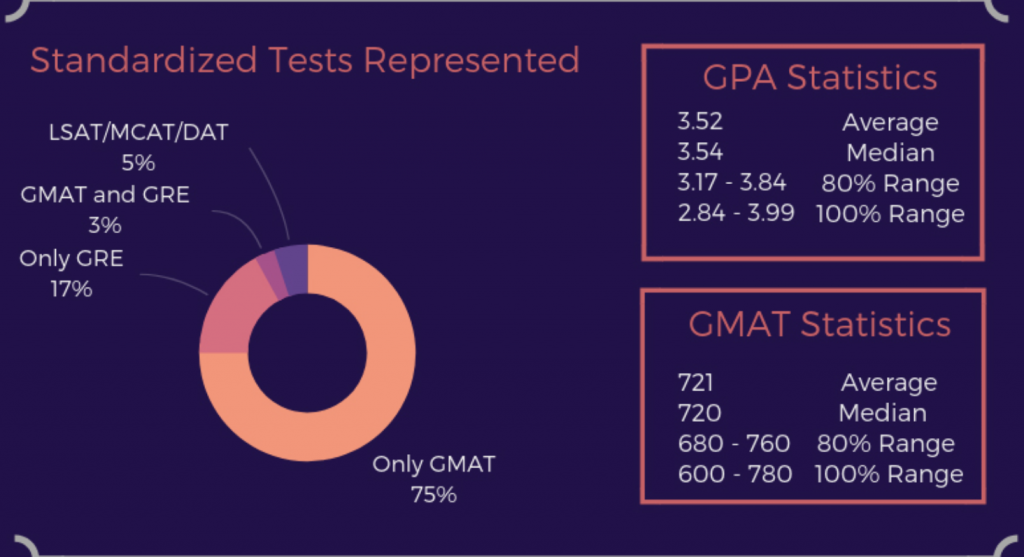Northwestern MBA Class of 2021 Introduced at Kellogg

The Northwestern MBA Class of 2021 at the Kellogg School of Management reflects the intelligence and diversity that the school is known for.
Continue reading…GMAT Scores, GPA, Rise Again for NYU Stern Class of 2021

NYU Stern got a jump start on introducing its full-time MBA Class of 2021.
Of the 3,518 applicants hoping to join the NYU Stern Class of 2021, only 919 were admitted and 359 enrolled, for a 26 percent admission rate. Those students are, on average, 28 years old and have 5.2 years of professional experience. A few of them were also fresh graduates, with 3 percent having no work experience.
Dramatic Jumps in Academic Performance

One of the major highlights from the NYU MBA Class of 2021 is the improved academic performance of the candidates.
- The average GMAT score rose 5 points, from 716 to 721
- Average GPAs increased from 3.45 to 3.52
There was also quite a difference regarding undergraduate majors. While a quarter of the Class of 2020 majored in business, that percentage increased to 30 for the new group. Meanwhile, the choice of engineering, math, or science as a major matched last year’s candidates at 22 percent. The third most popular major for the Class of 2021 was social sciences (19 percent) followed by economics (15 percent). This is a reverse of last year when a fifth of the class were economics majors.
Women on the Rise, Veterans Hold Steady
The NYU MBA Class of 2021 is expected to arrive on campus with more women than last year—female enrollment rose from 35 percent to 36 percent. However, international diversity decreased slightly. Only 33 percent of the Class of 2021 maintains international citizenship in 37 different countries, compared to 39 percent last year.
There was also a slight decrease in the number of minorities represented in the student body. In the Class of 2021, around a quarter of students (24 percent) identify as minorities, 9 percent of whom are underrepresented minorities. That’s down from 29 percent and 13 percent from last year. However, 7 percent of students are still U.S. Military veterans or on active duty, which is owed in part to the Fertitta Veterans Program.
Work Experience and Industry Background
Students entering the NYU MBA Class of 2021 come from a wide range of industries and backgrounds, the most popular being financial services (28 percent). After that, prior industries are widely mixed with no other industry breaching 12 percent of the class. They include:
- Consulting, 11 percent
- Technology, 9 percent
- Consumer, Products, Retail, 7 percent
- Nonprofit, Arts, Education, 7 percent
To see the full profile as of July 31, 2019, visit the Stern full-time MBA admissions website.
This article has been edited and republished with permissions from its original source, Clear Admit.
Berkeley Welcomes Record Number of MBAs in for Class of 2020

Last week, UC Berkeley’s Haas School of Business unveiled stats for the incoming students that comprise its full-time MBA Class of 2020.
With 291 full-time MBA students (along with 276 evening and weekend students), the Berkeley Class of 2020 is larger than any before.
The new class one of the most academically accomplished in school history. Average GPA for this year’s first-year class is 3.66, off just .05 from last year’s. But an increase in average GMAT offset the tiny backslide in GPA. At 726, it moved up one point higher than last year’s incoming class.
In terms of professional experience, Haas students come from various backgrounds. About a quarter of the students come from the consulting industry, and another 20 percent come from banking/financial services backgrounds. The industries drawing the third-, fourth-, and fifth-most Haas grads are high tech (10 percent), nonprofit (9 percent), and healthcare/pharmaceutical/bio (7 percent). In addition, 5 percent of the incoming class has military experience.
The percentage of women in Haas’s incoming class is also up over the previous year, something we’ve also seen this year at Northwestern’s Kellogg School, Duke’s Fuqua School, and USC Marshall, among others.

About 43 percent of the incoming Berkeley Class of full-time MBAs are women—a 3 percent increase. International students from 30 countries make up around 34 percent of the class, down from 39 percent last year. Here, too, Haas is not alone. Many U.S. schools have shared, in both in published class profiles and informal conversations, that international application volume was down, or at best, flat year over year.
Former Haas Dean Richard Lyons stepped down in June after 11 years with the school, a role in which he raised more money than any prior dean and oversaw the construction of Connie & Kevin Chou Hall. The addition of the new building helped make it possible to expand the Haas class, an effort Lyons championed. He and other supporters viewed it as a way to help ensure that Haas has enough graduates to command attention from the world’s top recruiters without compromising the intimacy and culture.
“Part of the reputation of the school is a function of its scale, and there are times where you are just not at the right reputational scale. You’re too small,” he explained in a 2017 interview with Clear Admit.
“It’s a super intimate experience—there’s no question about that—but target companies want to go to a place where there are enough people graduating that they can send a team of recruiters, for example. If you are too small you are below the threshold.”
Ann Harrison, a renowned economist and member of the faculty at the University of Pennsylvania’s Wharton School, will serve as Haas’s next dean. Harrison begins her term on January 1, 2019. Professor Laura Tyson, the current interim dean since Lyons left, returns to her prior faculty positions next year.
This article has been edited and republished with permissions from Clear Admit.
HBS Class of 2019 Profile Reveals Subtle Shifts, New GRE Details

The official Harvard Business School (HBS) Class of 2019 profile is now out—capturing in numbers and pie charts the real live students who started class for the first time yesterday. Not a lot has shifted since HBS released its preliminary class profile earlier this summer, although the Class of 2019 now includes 928 students, suggesting that 13 of those the school was expecting to enroll when it originally reported the class size at 941 made other plans. There are 942 students in the Class of 2018, by comparison.
The percentage of minority students also slipped slightly, from 26 percent reported in the preliminary profile to 25 percent in the actual class (last year’s actual percentage was 26 percent). Female students comprise 42 percent of the class, as earlier reported, again down one percentage point from last year.
In terms of median GMAT, 730 is still HBS’s reported score. That’s the same as last year—and as predicted earlier in the summer. The score range reported included a low of 580 and a high of 790, with the middle 80 percent of the class falling between 700 and 770. Last year, the middle 80 percent was a shade lower, coming in between 690 and 760.
HBS Joins Wharton, Yale in Posting GRE Scores
New in the actual profile posted today are stats on GRE scores, marking the first time HBS has published such data. Chad Losee, the Managing Director of Admissions and Financial Aid, also made a point of sharing this information in a recent blog post, revealing that 12 percent of the class submitted GRE scores and the remaining 88 percent submitted GMAT scores.
“The GRE and GMAT are different tests … and we are truly indifferent about which one you submit,” Losee writes. “Really. We are familiar with each test. Choose the one that allows you to best show your strengths, then move on to the other parts of the application.”
According to the recently posted profile, median GRE scores for both verbal and quantitative at HBS were 164. The score range for verbal was 147 to 170, and the range for quantitative was 151 to 170. HBS did not provide information about the average writing score.
The Wharton School, too, shared GRE data for the first time this year, although specific details about what percentage of the class opted for one test over the other were not made available. Wharton reported average scores, not median scores: 163 verbal, 162 quantitative, and a 4.7 average writing score. The Yale School of Management (SOM) also included GRE test scores in its Class of 2019 profile (median verbal, 166; median quantitative, 164; middle 80 percent verbal, 157 to 170; middle 80 percent quantitative, 160 to 169.)
If three makes a trend—then a trend we have of leading schools emphatically underscoring that they are indeed test agnostic by including GRE scores within their official class profiles.
“We Know You’re Much More Than a Test Score”
In his post, Losee also took pains to underscore that much more than scores go into determining who joins the HBS class each year.
“We know you are much more than a test score,” he writes. “The whole application and interview process are designed to help us get to know you. We’re trying to imagine what you would contribute in the HBS classroom and community. As I’ve written before, our learning model depends on a wide range of talent and perspectives in each class—and we know that not all that talent is measurable in a test.”
Obviously unchanged from the preliminary profile were the total number of applications HBS received this year—10,351—a 6 percent uptick over last year. The profiles posted today and earlier this summer both cited an 11 percent admission rate—which would indicate that 1,138 students made the cut—and a 91 percent yield.
This story has been edited and republished with permissions from Clear Admit.
